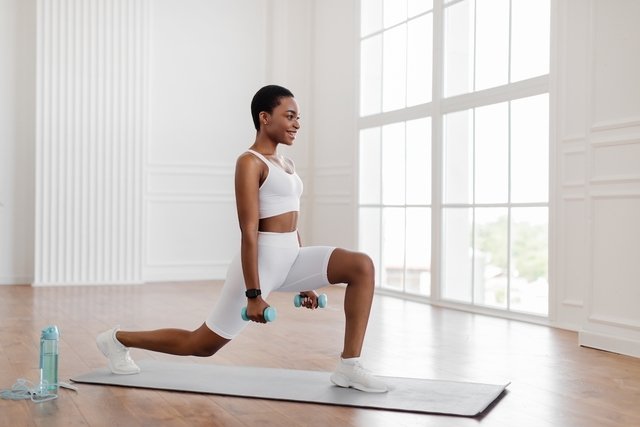Lunges are a resistance and mobility exercise that serves to strengthen and increase muscle mass in the lower limbs, as it works the glutes, thighs and calves. In addition, lunges can also help with weight loss and strengthen the muscles in the back and abdominal region.
This exercise, also known as deep squats, can be done in gyms, at home or outdoors, with different variations, which although they work the same muscles, activate muscle fibers with different intensities.
The lunge must be done with the guidance of a physical education professional who can indicate the variation of this exercise, in addition to being able to guide the use of dumbbells, according to each person’s physical condition and training objective.

What is it for
Lunges serve to increase lean mass and muscle strength, especially in the lower part of the body, working the muscles:
- Quadriceps, on the front of the thighs;
- Adductor magnus, on the inside of the thighs;
- Hamstrings, on the back of the thighs;
- Gluteus maximus and medius;
- Calves;
- Core muscles, which involve the abdomen, pelvis, lower back, hips, and perineum.
Furthermore, lunges help with body mobility, as well as balance, flexibility, coordination and body stability.
Does lunge lose weight?
Lunges can help you lose weight, as they help increase lean mass and reduce body fat, increasing metabolism and burning calories.
Therefore, this exercise can be a benefit for those who want to lose weight, as long as it is combined with a balanced diet guided by a nutritionist. See how to eat a balanced diet.
How to make
To do the stationary lunge, you must:
- Stand up straight and take a step forward with one of your legs;
- Bend your knees slowly, until the thigh of the leg in front is parallel with the floor;
- The front knee should not exceed the measurement of the toes;
- The back leg is also flexed, so that the knee points towards the floor, until it almost touches the floor;
- Your back foot should be flexed, resting on your toes.
- Return to the starting position, keeping your weight on the heel of your front foot;
- Repeat the movement 15 to 20 times for 2 to 3 sets for each leg, or as directed by the physical education professional.
While performing the lunge, it is important to keep your spine straight and your abdomen contracted.
Lunges with dumbbells or barbell
Lunges can also be done with dumbbells, in order to increase the difficulty of the exercise and increase muscle mass. To do this, you must use a dumbbell in each hand, with your arms stretched out in line with your body.
Another option is to do lunges with a barbell, using weights on the bar, at the gym. The weight of each dumbbell or bar must always be guided by the physical education professional.
If you don’t have dumbbells and want to perform this exercise at home, you can use a bottle pet filled with water or sand or a 1kg package of rice or beans, for example.
Lunge variations
In addition to the stationary lunge, which the person does without leaving their seat, there are some variations that can be done to activate muscle fibers with different intensities, the main ones being:
1. Walking lunges
The walking lunge is done with the same movement as the stationary lunge, but taking steps forward, as if you were walking, which allows you to rest between the legs in one step and another, as it alternates the legs.
Furthermore, this type of lunge, also known as lunge lunge, improves body balance and coordination, and works the core, glutes and hip muscles, mainly.
2. Side lunge
The lateral lunge is another variation of the lunge and is done with the person taking a step to the side, instead of stepping forward.
This type of lunge is also stationary, as the person does not move in place, and helps to work the muscles in the inner thigh more intensely, in addition to improving coordination and balance.
3. Reverse Lunge
The reverse lunge is done with the person stepping backwards, that is, instead of taking a step forward with one of the legs, as in stationary or walking lunges.
This type of lunge works the calves and glutes more intensely, in addition to the hamstrings and core muscles, responsible for the support and stability of the body.
4. Lunge with twist
The twisting lunge, also known as the lunge with twist or lunge twistis done by turning the torso to the side, while maintaining the lunge position.
This type of lunge can be done during the stationary lunge, walking lunge or reverse lunge, and twisting allows you to work the core muscles more intensely, in addition to balance and coordination.
5. Step lunges
The step lunge is a type of stationary lunge, in which when stepping forward, you place your foot on the step, which allows you to work the muscles of your back, legs and hips more intensely.
This type of lunge also improves coordination, mobility and balance, and should be done by lowering the back leg as far as possible, without touching the floor, to recruit more muscle fibers.
6. Alternating lunges
The alternating lunge is done in the same way as the stationary lunge, with the person stepping forward with one of the legs, or as in the reverse lunge, with the person stepping backwards.
Furthermore, this type of lunge can also be done during walking lunges, which helps to work both on balance and accelerates the heart rate, which can enhance fat burning.
7. Jump lunges
The jump lunge can be done while performing the reverse lunge, making a small jump while alternating legs.
This type of lunge is more complex, being more difficult, complex and intense to do, as correct posture and adequate physical preparation are necessary to avoid injuries.
Furthermore, lunges with alternating jumps are a cardiovascular exercise that increases the heart rate and can enhance fat burning.
8. Smith Lunge
The Smith lunge is a variation of the lunge done on the Smith machine at the gym, in which you can also perform the Smith squat. Learn how to do the Smith squat.
This machine has a fixed bar, to which you can add weights, to enhance the benefits of lunges.
Furthermore, it is possible to combine the use of steps with this exercise. However, it is important to highlight that this exercise must be done under the supervision of a physical education professional, as it is more complex.
Care when doing the lunge
When performing the lunge, it is important to take some precautions to ensure a correct position and avoid injuries:
- Keep your spine straight, abdomen contracted, head straight and aligned with your spine;
- Do not bend your knees outward or inward to avoid injuries;
- Maintain hip stability, without moving them forward when making movements;
- Inhale when lowering the leg and exhale on the way up;
- Use the amount of weight of the dumbbells or bar indicated by the physical education professional, in order to avoid overload or muscle injuries;
- Use the elastic band, step or bosu, if indicated by the physical education professional, to avoid injuries
Furthermore, it is also important to always consult a general practitioner or cardiologist before starting any type of physical exercise, to assess your general health and cardiovascular system.
If you want a medical evaluation, make an appointment with a cardiologist in the nearest region:
Taking care of your health has never been easier!

Sign up for our newsletter and stay up to date with exclusive news
that can transform your routine!
Warning: Undefined array key "title" in /home/storelat/public_html/wp-content/plugins/link-whisper-premium/templates/frontend/related-posts.php on line 12
Warning: Undefined array key "title_tag" in /home/storelat/public_html/wp-content/plugins/link-whisper-premium/templates/frontend/related-posts.php on line 13



